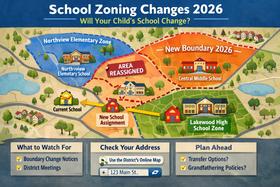Dysart Schools is a school district in Maricopa County, Arizona. It has 24,000 pre-kindergarten through 12th grade students in the Northwest Phoenix Metropolitan area.
Dysart Ischool ranks in the top 50% of all schools in Arizona for overall test scores (math proficiency is top 50%, and reading proficiency is top 50%).
The percentage of students achieving proficiency in math is 21-39% (which is approximately equal to the Arizona state average of 34%). The percentage of students achieving proficiency in reading/language arts is 48% (which is higher than the Arizona state average of 40%).
Quick Facts (2025-26)
- Grades: 7-12
- Graduation Rate: <50% (Btm 50% in AZ)
- Overall Testing Rank: Top 50%
- Math Proficiency: 21-39% (Top 50%)
- Reading Proficiency: 48% (Top 50%)
- Science Proficiency: 23% (Top 50%)
- Source: National Center for Education Statistics (NCES), AZ Dept. of Education
Top Rankings
Dysart Ischool ranks among the top 20% of public schools in Arizona for:
Category
Attribute
Community Size
Student Attention
School Overview
Grades Offered
Grades 7-12
(Exclusively virtual)
(Exclusively virtual)
Total Students (22-23)
106 students
Total Classroom Teachers (22-23)
13 teachers
Year Founded
1920
School Motto
Excellence in the Journey, Success for a Lifetime
Average Class Size
15 students
School Rankings
Dysart Ischool ranks within the top 50% of all 1,921 schools in Arizona (based off of combined math and reading proficiency testing data).
Overall Testing Rank
#709 out of 1921 schools
(Top 50%)
(Top 50%)
Math Test Scores (% Proficient)
21-39%
34%
Reading/Language Arts Test Scores (% Proficient)
48%
40%
Science Test Scores (% Proficient)
23%
24%
Student-Teacher Ratio
n/a
17:1
American Indian
1%
5%
Asian
1%
3%
Hispanic
47%
47%
Black
2%
6%
White
42%
35%
Hawaiian
n/a
n/a
Two or more races
7%
4%
Graduation Rate
<50%
77%
Eligible for Free Lunch
5%
39%
Eligible for Reduced Lunch
1%
7%
School Statewide Testing
School District Name
Source: National Center for Education Statistics (NCES), AZ Dept. of Education
Profile last updated: 02/09/2025
Frequently Asked Questions
What is Dysart Ischool's ranking?
Dysart Ischool is ranked #709 out of 1,921 schools, which ranks it among the top 50% of public schools in Arizona.
What schools are Dysart Ischool often compared to?
Dysart Ischoolis often viewed alongside schools like Paradise Honors High School, Willow Canyon High School by visitors of our site.
What percent of students have achieved state testing proficiency in math and reading?
21-39% of students have achieved math proficiency (compared to the 34% AZ state average), while 48% of students have achieved reading proficiency (compared to the 40% AZ state average).
What is the graduation rate of Dysart Ischool?
The graduation rate of Dysart Ischool is 50%, which is lower than the Arizona state average of 77%.
How many students attend Dysart Ischool?
106 students attend Dysart Ischool.
What is the racial composition of the student body?
47% of Dysart Ischool students are Hispanic, 42% of students are White, 7% of students are Two or more races, 2% of students are Black, 1% of students are American Indian, and 1% of students are Asian.
What grades does Dysart Ischool offer ?
Dysart Ischool offers enrollment in grades 7-12 (Exclusively virtual).
What school district is Dysart Ischool part of?
Dysart Ischool is part of Dysart Unified District (4243).
School Reviews
Review Dysart Ischool. Reviews should be a few sentences in length. Please include any comments on:
- Quality of academic programs, teachers, and facilities
- Availability of music, art, sports and other extracurricular activities
Recent Articles

Public School Open House & Enrollment Season Guide for Parents
Learn what to ask at a public school open house during enrollment season, from academics to safety, to choose the right school for your child.

School Zoning Changes 2026: How Assignments May Shift
School Zoning Changes 2026 could affect your child’s school assignment. Learn how zoning works, what is changing, and how families can prepare.

School Vouchers: Updated Pros and Cons (2025 Review)
Comprehensive 2025 analysis of school vouchers, weighing benefits and challenges for families, funding, outcomes, and policy directions.





